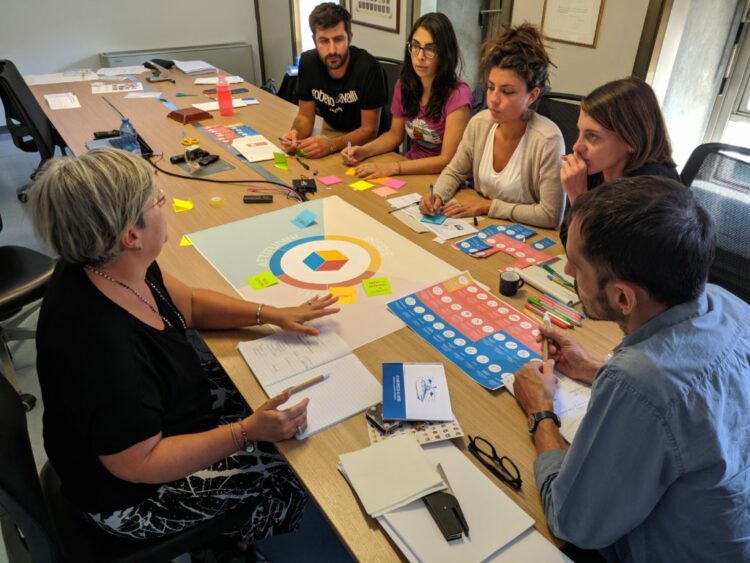Using design capabilities to build values and the right kind of engagement.
By Federico Rita. This blog post was written for designscapes.eu
If you are a design practitioner, you have probably asked yourself at some point, during a creative session: “How do I make these people trust design?”
While reflecting on that question, I realised that as creative enablers, we do more than merely applying design principles — we inherently embed values and meaning in our application of design, and as such, we can catalyse and tailor these values to each and any specific audience. Sharing this reflection with our collaborators as we bring them into our process is essential to build trust: We can make others trust us and trust design by helping them trust their use of design. This process should be a spontaneous one, focused on hands-on experience and finding the right balance of ingredients that help create an engaging, participatory climate.
I had the opportunity to explore how to foster such a collaborative environment during a research project for my master’s thesis. The project was the result of the collaboration of the Participatory City Making Lab (Industrial Design Engineering faculty of TU Delft), and ANCI Toscana, which are both members of the DESIGNSCAPES consortium. ANCI Toscana is a non-profit organisation, operating as the regional association of municipalities in Tuscany, Italy. As an organisation that manages projects with different districts and supports a vast network of civil servants, ANCI Toscana has a broad outreach and communicative power.
The purpose of the project was to investigate strategies to strengthen public management by exploring the potential of Design Thinking as a policy competency. A design capacity-building process was initiated and carried out as part of the design challenge to co-create a learning environment for design-capabilities development. Participatory design was selected as the approach to creating a safe space that would allow for sharing and nurturing design knowledge, skills and attitudes. The project was articulated in four phases, to facilitate a progressive iterating on the learning environment. The project cycles allowed for a thorough and proactive discussion around the good practices learned during the process — the most important of which are highlighted in the following paragraphs.
Choosing a non-profit organisation which operates in the public management domain represented an opportunity to carry out a practice-based study, and subsequently, to gather a close understanding of public managers’ working and co-learning processes.
A crucial aspect was to consider both their context and the way they interact with it at a local level. The context is what truly defines and gives depth to a social development project. How contextual factors tie together and describe interactions between people and, in turn, between people and their context, inspired the project from its early stages.
“The context is what truly defines and gives depth to a social development project.”
The keystone of the process was kickstarting an empathetic and active discussion, enriched by personal opinions. At that moment, I realised the importance of sharing and discussing values when designing for the public good. The activities were carried out in the participants’ native language, to set necessary conditions for them to relate to the process and all the contents. A familiar language, as well as any kind of shared communication code, enables a free and unfiltered expression, allowing for unique and sincere insights.
As a consequence, this deep dive into intimate experiences opens up to spotting personal values. The holistic view offered by value-mapping allows for uncovering what is relevant in a given situation, the here-and-now that might be missed by only focusing on quantity. Here is where Participatory design can play a significant role, especially in collaborative settings aimed at cooperating in their turns with broader audiences.

The group of public managers of ANCI Toscana discussing the value-mapping activity during a creative session led by Federico Rita
To make the project resilient, at the end of the research, I mapped six guidelines on how to implement a learning environment for design capabilities development in practice:
• Share the process, share the outcome: democratise tools, methodologies and results of every process by making them available and reusable.
• Embrace complexity by means of simplicity: do not be discouraged by open, complex, dynamic and networked challenges. Decompose complex issues one step at the time in order to create a framework of achievable goals.
• Mediate personal motivations and values to enhance participation: real engagement comes from motivation, and proactive participation is the result of a balance between individual incentives and team’s ambitions.
• Learn from participants and let them share their knowledge: inspiring experiences have intrinsic and motivational power. Let public managers express their knowledge, to benefit the whole team.
• Make the debate visible and tangible: materialise abstract discussions employing artefacts, to take the debate to a relatable level and to generate contextual awareness.
• Make tools adapt to participants and not vice versa: shared ownership can be achieved by allowing public managers to add a personal touch on tools and methods so that they can feel responsible for the whole learning process.
There is no perfect formula to build trust, simply because it is not measurable. However, the way in which design participants engage and gather around shared values can be a fair indicator of trust. The proposed guidelines are meant as a compass to find a good balance between active engagement and trust towards design capabilities, to confidently explore novel ways of collaborating.
*with Alicia Calderon Gonzalez, Ingrid Mulder and Besnik Mehmeti.
All photos: Federico Rita